Happy Holidays and Happy New Year!
Dec 23, 2009
Dec 20, 2009
At Jamaica Pond
 Since the first time I saw this tree in the middle of Jamaica Pond I have been fascinated by it. My wife Helen and I sometimes walk around the pond for a stroll and I often think about how to capture this tree at its most beautiful. I never succeeded or even really tried since the shoreline behind is covered with the boat house and residential buildings. Last year though, on a foggy morning, I decided to make my way over to the Boston Arnold Arboretum for a photo excursion. When I turned the keys to start up my car that morning I already knew that I was in for a special treat. When driving up the road leading to Jamaica Pond I saw heavy fog across the pond. Excitement immediately rose and a smile crossed my lips. When I finally turned around the corner to the main pond road the perfect picture arose out of fog. Best of all there was no distracting background. I instantly made a u-turn to park the car, pulled out my tripod from the trunk and walked down to the shoreline and followed the dirt path around the pond looking for the best composition. I didn't need to walk far and only a few joggers passed me I set-up the tripod, composed my image a little bit off center and included the tree reflection. The focal length was zoomed to about 80mm and the aperture setting was f/5.6 resulting in a shutter speed of 1/13 sec. Once I knew I had my image I took a deep breath of joy and moved on to my original destination, the Boston Arnold Arboretum.
Since the first time I saw this tree in the middle of Jamaica Pond I have been fascinated by it. My wife Helen and I sometimes walk around the pond for a stroll and I often think about how to capture this tree at its most beautiful. I never succeeded or even really tried since the shoreline behind is covered with the boat house and residential buildings. Last year though, on a foggy morning, I decided to make my way over to the Boston Arnold Arboretum for a photo excursion. When I turned the keys to start up my car that morning I already knew that I was in for a special treat. When driving up the road leading to Jamaica Pond I saw heavy fog across the pond. Excitement immediately rose and a smile crossed my lips. When I finally turned around the corner to the main pond road the perfect picture arose out of fog. Best of all there was no distracting background. I instantly made a u-turn to park the car, pulled out my tripod from the trunk and walked down to the shoreline and followed the dirt path around the pond looking for the best composition. I didn't need to walk far and only a few joggers passed me I set-up the tripod, composed my image a little bit off center and included the tree reflection. The focal length was zoomed to about 80mm and the aperture setting was f/5.6 resulting in a shutter speed of 1/13 sec. Once I knew I had my image I took a deep breath of joy and moved on to my original destination, the Boston Arnold Arboretum.Dec 13, 2009
Monthly Photo Tip - December 2009
 Silky and velvety water effects are best photographed with a tripod for optimal image quality and minimum blurriness of the surrounding landscape during the desired longer exposure times. The polarizer filter not only reduces image brightness and provides longer exposure times but also eliminates reflections from wet surfaces and increases color saturation.
Silky and velvety water effects are best photographed with a tripod for optimal image quality and minimum blurriness of the surrounding landscape during the desired longer exposure times. The polarizer filter not only reduces image brightness and provides longer exposure times but also eliminates reflections from wet surfaces and increases color saturation.Shutter speeds at around 1/2 through 1/15 of a second produce velvety and silky effects for streams, rivers and cascading water. A good starting point for waves and surfs are shutter speeds up to 1 second or more. Freezing action starts with shutter speeds of 1/30 of a second or faster depending on your focal length.
Dec 10, 2009
In Cambridge
 A couple of weekends ago, Helen and I took a long walk from Brookline to Cambridge along the Charles river. It was one of these windy beautiful fall mornings in Boston. When she called home to check in, I got my camera ready for shooting leaves blowing in the wind. The leaves were swirling all over the place and I thought it might make for an interesting photograph. I actually had this on my mind for quite some time now but never got around to capturing anything close. I went down on the ground to get a different perspective, zoomed all out to set the lens to its widest wide angle setting, focused on the leaves in front of me and waited for the next wind gust to blow the leaves across the field. Then I waited again and captured the next round of images. At one point the camera view was half covered by a single leaf which made for an interesting capture as well. The one shown here is my favorite photograph of the series because of the minimum depth of field; it is closest what I was hoping to capture with my camera.
A couple of weekends ago, Helen and I took a long walk from Brookline to Cambridge along the Charles river. It was one of these windy beautiful fall mornings in Boston. When she called home to check in, I got my camera ready for shooting leaves blowing in the wind. The leaves were swirling all over the place and I thought it might make for an interesting photograph. I actually had this on my mind for quite some time now but never got around to capturing anything close. I went down on the ground to get a different perspective, zoomed all out to set the lens to its widest wide angle setting, focused on the leaves in front of me and waited for the next wind gust to blow the leaves across the field. Then I waited again and captured the next round of images. At one point the camera view was half covered by a single leaf which made for an interesting capture as well. The one shown here is my favorite photograph of the series because of the minimum depth of field; it is closest what I was hoping to capture with my camera.Dec 7, 2009
In Brookline
 New England Landscape photography is on display in the solo exhibit New England Landscapes. The exhibition features 11 New England landscape photographs from the Boston Arnold Arboretum to Acadia National Park. The exhibit runs from November 20, 2009 through January 15, 2010 and is organized by the Brookline Commission for the Arts. Photographs are on display in the gallery of the Selectmen's Hearing room of the Brookline Town Hall, 333 Washington Street.
New England Landscape photography is on display in the solo exhibit New England Landscapes. The exhibition features 11 New England landscape photographs from the Boston Arnold Arboretum to Acadia National Park. The exhibit runs from November 20, 2009 through January 15, 2010 and is organized by the Brookline Commission for the Arts. Photographs are on display in the gallery of the Selectmen's Hearing room of the Brookline Town Hall, 333 Washington Street.Dec 5, 2009
In Cambridge
 Cape Cod Solitude on display in the group exhibit "Red It's more than a color" at the University Place Gallery in Cambridge, MA. All artwork was juried by Carl Belz, Director Emeritus of the Rose Art Museum at Brandeis University. The exhibition features many artists and runs from November 10, 2009 through January 14, 2010 in the Kathryn Schultz gallery and University Place gallery. The Kathryn Schultz gallery is located at 25 Lowell St. in Cambridge, MA 02138 and is open to the public Tuesday through Saturday, 11am to 5pm. University Place gallery is only a block away at 124 Mt. Auburn St. in Cambridge, MA 02138 and is open Monday through Friday from 9am to 6pm and Saturday 9am to 1pm.
Cape Cod Solitude on display in the group exhibit "Red It's more than a color" at the University Place Gallery in Cambridge, MA. All artwork was juried by Carl Belz, Director Emeritus of the Rose Art Museum at Brandeis University. The exhibition features many artists and runs from November 10, 2009 through January 14, 2010 in the Kathryn Schultz gallery and University Place gallery. The Kathryn Schultz gallery is located at 25 Lowell St. in Cambridge, MA 02138 and is open to the public Tuesday through Saturday, 11am to 5pm. University Place gallery is only a block away at 124 Mt. Auburn St. in Cambridge, MA 02138 and is open Monday through Friday from 9am to 6pm and Saturday 9am to 1pm.At Boston Arnold Arboretum
 People often ask me about my locations and are surprised that most of my images are taken locally. The snow covered evergreens are pften assumed to be from Vermont. Never been there for the snow season. These evergreens are actually in the Boston Arnold Arboretum which is located the middle of Boston. It was a mostly cloudy day after a heavy snowfall and most of New England was under a beautiful white snow blanket. I went out early in the morning and walked through the snow looking for great photo opportunities. It was not the great photography adventure I had expected but when I was about to leave the sun came out for a brief moment spotlighting the evergreen near one of the main entrances. The magic moment I was hoping for finally unfolded in front of me. The dark clouds in the background provided more dramatic appeal to the image and benefited the overall composition. I quickly opened my tripod, with the camera already mounted on it, composed a pleasing composition and captured a round of images. The moment only lasted for seconds until the sun disappeared again behind the clouds. With 3 to 5 inches in the forecast for tonight I am thinking of going back to the Boston Arnold Arboretum tomorrow morning to give it another try. The forecast predicts snowfall over night and a partially cloudy morning. Perfect conditions!
People often ask me about my locations and are surprised that most of my images are taken locally. The snow covered evergreens are pften assumed to be from Vermont. Never been there for the snow season. These evergreens are actually in the Boston Arnold Arboretum which is located the middle of Boston. It was a mostly cloudy day after a heavy snowfall and most of New England was under a beautiful white snow blanket. I went out early in the morning and walked through the snow looking for great photo opportunities. It was not the great photography adventure I had expected but when I was about to leave the sun came out for a brief moment spotlighting the evergreen near one of the main entrances. The magic moment I was hoping for finally unfolded in front of me. The dark clouds in the background provided more dramatic appeal to the image and benefited the overall composition. I quickly opened my tripod, with the camera already mounted on it, composed a pleasing composition and captured a round of images. The moment only lasted for seconds until the sun disappeared again behind the clouds. With 3 to 5 inches in the forecast for tonight I am thinking of going back to the Boston Arnold Arboretum tomorrow morning to give it another try. The forecast predicts snowfall over night and a partially cloudy morning. Perfect conditions!Dec 1, 2009
Nov 25, 2009
On the BU Bridge
 Post sunset is one of my favorite times to take photographs. I regularly go out and capture the Boston skyline at twilight on days that I am not occupied hunting for nature photographs. The best time is 20 to 30 minutes after the sun has set. The optimum light does not last long. Because twilight is hard to predict I set up my tripod and camera prior to the actual sunset and then fire away once the sun sets and disappears. This approach requires sufficient battery power and flash card memory to keep shooting while closing in on the optimum light. The twilight effect also works on cloudy days and 10-15 seconds exposure times are not unusual. I often set up on the BU bridge providing me with multiple challenges. First, there is the rush hour traffic that may cause shaking of the camera set up and therefore produce blurry photographs. Second, there are lots of pedestrians crossing the bridge and causing the same effect when passing by. And the final challenge is framing and composing the photographs in manual mode. In this photograph I decided to shoot landscape format and include the John Hancock building, a Boston landmark. I welcomed the BU sailing armada coming straight towards me because they added more interest to the foreground. The longer exposure time caused the sail boats to blur and added motion as well as an extra twist to the photograph. In the photograph below I used twilight to great effect in one of my nature photographs.
Post sunset is one of my favorite times to take photographs. I regularly go out and capture the Boston skyline at twilight on days that I am not occupied hunting for nature photographs. The best time is 20 to 30 minutes after the sun has set. The optimum light does not last long. Because twilight is hard to predict I set up my tripod and camera prior to the actual sunset and then fire away once the sun sets and disappears. This approach requires sufficient battery power and flash card memory to keep shooting while closing in on the optimum light. The twilight effect also works on cloudy days and 10-15 seconds exposure times are not unusual. I often set up on the BU bridge providing me with multiple challenges. First, there is the rush hour traffic that may cause shaking of the camera set up and therefore produce blurry photographs. Second, there are lots of pedestrians crossing the bridge and causing the same effect when passing by. And the final challenge is framing and composing the photographs in manual mode. In this photograph I decided to shoot landscape format and include the John Hancock building, a Boston landmark. I welcomed the BU sailing armada coming straight towards me because they added more interest to the foreground. The longer exposure time caused the sail boats to blur and added motion as well as an extra twist to the photograph. In the photograph below I used twilight to great effect in one of my nature photographs.Nov 22, 2009
In Central Park
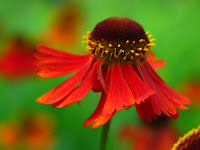 Last summer we spent quite some time in New York's Central Park. On the first morning we got up in the wee hours and waited in line to secure tickets to Shakespeare’s “Twelfth Night” with Anne Hathaway that night. At around noon we got four tickets and the show that evening in the public theater in New York Central Park was great. The very next morning we met up with our extended family and enjoyed a nice breakfast at a small outdoor cafe near the Central Park Carousel. As a passionate flower and nature photographer I realized the potential of the red and yellow Sneezeweed when we entered the cafe. After enjoying croissants, bagels and coffee with our family I stopped on the way out to capture some photographs. I used the fence to stabilize my camera since I didn't bring my tripod along. The Sneezeweed was in its full glory and it was not too difficult to locate one in front of a full green backdrop. All I had to do was compose my image with little depth of field to blur out background, focus on the petals and click away. The wind that day was quite strong and made it a greater challenge than expected but in the end I captured the photographs I was hoping for. I am very happy with the outcome of these two photographs on the fly.
Last summer we spent quite some time in New York's Central Park. On the first morning we got up in the wee hours and waited in line to secure tickets to Shakespeare’s “Twelfth Night” with Anne Hathaway that night. At around noon we got four tickets and the show that evening in the public theater in New York Central Park was great. The very next morning we met up with our extended family and enjoyed a nice breakfast at a small outdoor cafe near the Central Park Carousel. As a passionate flower and nature photographer I realized the potential of the red and yellow Sneezeweed when we entered the cafe. After enjoying croissants, bagels and coffee with our family I stopped on the way out to capture some photographs. I used the fence to stabilize my camera since I didn't bring my tripod along. The Sneezeweed was in its full glory and it was not too difficult to locate one in front of a full green backdrop. All I had to do was compose my image with little depth of field to blur out background, focus on the petals and click away. The wind that day was quite strong and made it a greater challenge than expected but in the end I captured the photographs I was hoping for. I am very happy with the outcome of these two photographs on the fly.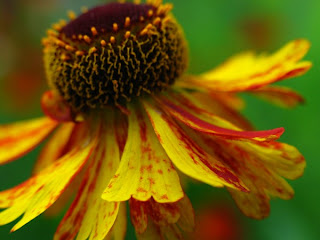
Nov 13, 2009
Monthly Photo Tip - November 2009
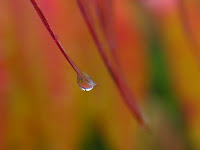 While looking for the last colors of fall in the Boston area I ended up in the beautiful Arnold Arboretum. After working some ivy and shrubs over a bolder I came across these orange and red leaf trees. The leaves were showing peak color and screaming for a photographers eye. The drizzling rain accumulated on the tips of the leaves and gravity pulled the leaves downwards forming nature abstracts and a feast for any photographer. It took a few attempts to isolate a single leaf with a raindrop since a couple of times I moved in too close and instead of snapping the photo I ended up with the raindrop on my lens. In the end I found my leaf, zoomed all in and opened the aperture all up to blur out the background. The next photograph shows the same kind of leaves but from a different perspective. Here I focused on one of multiple rain soaked leaves and played with the depth of field. The settings were the same: long focus length and wide aperture setting to produce a shallow depth of field.
While looking for the last colors of fall in the Boston area I ended up in the beautiful Arnold Arboretum. After working some ivy and shrubs over a bolder I came across these orange and red leaf trees. The leaves were showing peak color and screaming for a photographers eye. The drizzling rain accumulated on the tips of the leaves and gravity pulled the leaves downwards forming nature abstracts and a feast for any photographer. It took a few attempts to isolate a single leaf with a raindrop since a couple of times I moved in too close and instead of snapping the photo I ended up with the raindrop on my lens. In the end I found my leaf, zoomed all in and opened the aperture all up to blur out the background. The next photograph shows the same kind of leaves but from a different perspective. Here I focused on one of multiple rain soaked leaves and played with the depth of field. The settings were the same: long focus length and wide aperture setting to produce a shallow depth of field.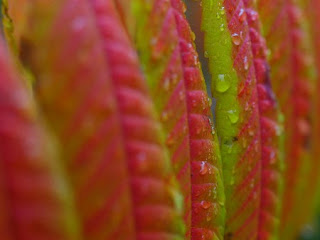
Nov 12, 2009
Nov 9, 2009
Win a Free Greeting Card!
Email me where in the world I was 20 years ago to help make world history. The first one to email me the correct answer at
Juergenrothphotography@gmail.com
will be awarded a free greeting card from my Fine Art America portfolio. Jokes about the outfit will result in automatic disqualification :-)
Please include in the subject line of your email "Greeting Card" and send me your choice of image for your free greeting card from my FAA portfolio.
Good luck!

Juergenrothphotography@gmail.com
will be awarded a free greeting card from my Fine Art America portfolio. Jokes about the outfit will result in automatic disqualification :-)
Please include in the subject line of your email "Greeting Card" and send me your choice of image for your free greeting card from my FAA portfolio.
Good luck!

Nov 7, 2009
Nov 1, 2009
Near Streams, Rivers and Cascading Water
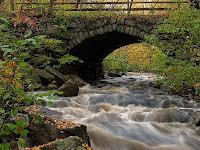 Moving water has become one of my favorite objects. These scenes are difficult to photograph but make for beautiful subjects. Sudbury River was one of my first of this kind. I first discovered the scene on a trip to one of my daugther's soccer games. The Fall foliage peak was almost over. When we came around the corner in our car I caught a glimpse of the bridge with the Sudbury river and committed the image to memory. Needless to say we won the game. Although the next day was overcast I decided to go back and work the object. Climbing down to the river was quite a hassle and adventure because of the slippery rocks and boulders but worth while. Turns out that overcast or twilight conditions are the most important ingredients when photographing moving water.
Moving water has become one of my favorite objects. These scenes are difficult to photograph but make for beautiful subjects. Sudbury River was one of my first of this kind. I first discovered the scene on a trip to one of my daugther's soccer games. The Fall foliage peak was almost over. When we came around the corner in our car I caught a glimpse of the bridge with the Sudbury river and committed the image to memory. Needless to say we won the game. Although the next day was overcast I decided to go back and work the object. Climbing down to the river was quite a hassle and adventure because of the slippery rocks and boulders but worth while. Turns out that overcast or twilight conditions are the most important ingredients when photographing moving water. 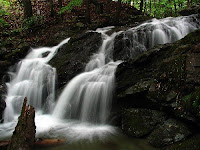 Shutter speed determines the silky effects. Short exposures freeze the water and often translates into less favorable images.
Shutter speed determines the silky effects. Short exposures freeze the water and often translates into less favorable images. 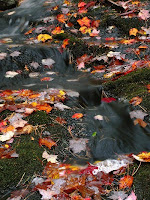 On the other hand, streaming waters provide wonderful silky shapes and patterns when longer exposure times are chosen.
On the other hand, streaming waters provide wonderful silky shapes and patterns when longer exposure times are chosen.A tripod for optimal image quality and minimum blurriness of the surrounding landscape during the longer exposure times is a must. The use of a polarizer filter eliminates reflections from wet surfaces and increases color saturation. The polarizer also reduces image brightness and provides longer exposure times, if needed.
Shutter speeds at around 1/2 through 1/15 of a second produce velvety and silky effects for streams, rivers and cascading water. Waves and surfs require shutter speeds around 1 second or more.
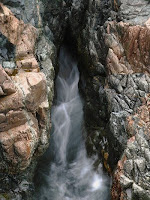
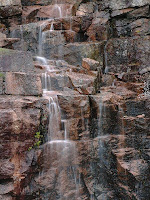
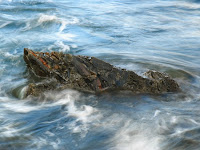
Oct 31, 2009
In Cambridge
 Cape Cod Solitude was accepted into the juried group art exhibit, Red: It's more than a color. The exhibition features many artists and runs from November 10, 2009 through January 14, 2010 in the Kathryn Schultz gallery and University Place gallery. The Kathryn Schultz gallery is located at 25 Lowell St. in Cambridge, MA 02138 and is open to the public Tuesday through Saturday, 11am to 5pm. University Place gallery is only a block away at 124 Mt. Auburn St. in Cambridge, MA 02138 and is open Monday through Friday from 9am to 6pm and Saturday 9am to 1pm.
Cape Cod Solitude was accepted into the juried group art exhibit, Red: It's more than a color. The exhibition features many artists and runs from November 10, 2009 through January 14, 2010 in the Kathryn Schultz gallery and University Place gallery. The Kathryn Schultz gallery is located at 25 Lowell St. in Cambridge, MA 02138 and is open to the public Tuesday through Saturday, 11am to 5pm. University Place gallery is only a block away at 124 Mt. Auburn St. in Cambridge, MA 02138 and is open Monday through Friday from 9am to 6pm and Saturday 9am to 1pm.Oct 25, 2009
In New England
 The 2009 Fall foliage season is now winding down here in the Boston area of New England and as every year has provided us with lots of black and white photo or color photos opportunities. Shooting Fall colors is an event I look forward to all year. This year was no different and I made mostly local trips but also finally got to experience Acadia National Park. All year I plan and look for Fall destinations and locations. I look forward to the first foliage report from the New England Fall Foliage network at New England Fall Foliage Network.
The 2009 Fall foliage season is now winding down here in the Boston area of New England and as every year has provided us with lots of black and white photo or color photos opportunities. Shooting Fall colors is an event I look forward to all year. This year was no different and I made mostly local trips but also finally got to experience Acadia National Park. All year I plan and look for Fall destinations and locations. I look forward to the first foliage report from the New England Fall Foliage network at New England Fall Foliage Network.  The foliage network is my major source for finding beautiful Fall colors in New England. Every Wednesday and Saturday the network provides updates on color and leaf drops throughout the region. Usually I try to time my trips when the map shows high color. I found that best colors have already passed when peak is indicated on the maps.
The foliage network is my major source for finding beautiful Fall colors in New England. Every Wednesday and Saturday the network provides updates on color and leaf drops throughout the region. Usually I try to time my trips when the map shows high color. I found that best colors have already passed when peak is indicated on the maps.
Prior to my trips I look into where and what I am going to shoot. Local  destinations like the Arnold Arboretum or State Parks within an hour of Boston are preferred when there is only limited time. Longer photo trips are dedicated to Acadia National Park, The Whites, Green Mountains or Cape Cod. Often I find myself browsing the local bookstore or the net to find information about new locations and photo objects. The AMC hiking guides come in handy when I decide to just take off for a hike into the woods or the mountains.
destinations like the Arnold Arboretum or State Parks within an hour of Boston are preferred when there is only limited time. Longer photo trips are dedicated to Acadia National Park, The Whites, Green Mountains or Cape Cod. Often I find myself browsing the local bookstore or the net to find information about new locations and photo objects. The AMC hiking guides come in handy when I decide to just take off for a hike into the woods or the mountains.
 destinations like the Arnold Arboretum or State Parks within an hour of Boston are preferred when there is only limited time. Longer photo trips are dedicated to Acadia National Park, The Whites, Green Mountains or Cape Cod. Often I find myself browsing the local bookstore or the net to find information about new locations and photo objects. The AMC hiking guides come in handy when I decide to just take off for a hike into the woods or the mountains.
destinations like the Arnold Arboretum or State Parks within an hour of Boston are preferred when there is only limited time. Longer photo trips are dedicated to Acadia National Park, The Whites, Green Mountains or Cape Cod. Often I find myself browsing the local bookstore or the net to find information about new locations and photo objects. The AMC hiking guides come in handy when I decide to just take off for a hike into the woods or the mountains. Although a pain to carry along, a tripod is a must. Filters like the polarizer or neutral density filters are indispensable for achieving stunning imagery. Cloudy, overcast mid-mornings provide optimal shooting conditions with minimal wind and good light. This is the time to get up close near brooks or creeks to photograph Fall colored leaves, rushing brooks or Fall foliage landscapes. The overcast sky does not add to the compositions and is eliminated from the frame. Wet vegetation in combination with the polarizer provide me with highest color saturation. I am always on the lookout to combine
Although a pain to carry along, a tripod is a must. Filters like the polarizer or neutral density filters are indispensable for achieving stunning imagery. Cloudy, overcast mid-mornings provide optimal shooting conditions with minimal wind and good light. This is the time to get up close near brooks or creeks to photograph Fall colored leaves, rushing brooks or Fall foliage landscapes. The overcast sky does not add to the compositions and is eliminated from the frame. Wet vegetation in combination with the polarizer provide me with highest color saturation. I am always on the lookout to combine  warm Fall hues with their complementary colors like red with green or yellow with blue. Photographing Fall colors on bright sunny days adds additional depth to images when including a blue sky in the compositions. The sunlight really makes the colors pop.
warm Fall hues with their complementary colors like red with green or yellow with blue. Photographing Fall colors on bright sunny days adds additional depth to images when including a blue sky in the compositions. The sunlight really makes the colors pop.

Artistic approaches for autumn photos include foliage in motion for example, solid trunks with leaves moving in the wind, fallen leaves against a milky, rushing brook or a batch of patterned color from atop a hill.


Oct 19, 2009
Win a Free Greeting Card!
Email me the number of photographers in this Granite Coast photograph from Acadia National Park and win a free greeting card from my Fine Art America portfolio for free! Click on the image to enlarge.
Oct 17, 2009
Monthly Photo Tip - October 2009

Last weekend I spent 3 full days in Acadia National Park in Maine. On my last day I was looking to shoot Bass Harbor lighthouse. When I arrived the place was a mob scene. Not totally unexpected, but still surprising to see probably 25 to 30 people on the rocks at the bottom of the lighthouse. Other photographers had already marked the perfect locations their own. I had no choice but to back up and walk across the granite rocks and set up further away. Of course I had the whole crowd in my frame but I also knew what I was waiting for, twilight. These morning and evening limited minutes provide exceptional light for glorious and dramatic landscape photography. So, I chilled out, like my daughter frequently suggests. I turned around to capture the red granite rocks painted by beautiful evening light while most people were focusing on the lighthouse and the sunset. Once the sun set, flashlights were lighting the scene and cameras were released left and right. After a few minutes, people started to leave, including most of the photographers. In the end there were just three photographers left, one who claimed the top spot from the start, one who got lost on the way to the location and myself. A fourth gentleman was enjoying a bottle of wine, amused that I praised my fellow photographer for arriving just in time to capture Bass Harbor light at its best. The three of us now filled up our flash cards with I believe some of the best Bass Harbor lighthouse photographs taken that night.


Oct 12, 2009
At White Mountains
 Sabbaday Brook is another photograph that I am often suspected of having staged. As discussed with Spiral Rose in an earlier post this is what nature provided me and I was lucky enough to stumble across this incredible setting that day. Call it being in the right place at the right time. The photograph was taken on the way back from the Sabbaday Falls in the White Mountains of New Hampshire. The falls turned out to be quite a disappointment or maybe I simply was not inspired to produce something beautiful. On the way back I focused on the the rocks and stream instead and while walking downstream I discovered the setting. I composed the image so that the leaf leads into the photograph and keeps you right there. In order to do so I had to manoveur my tripod set up on other rocks and partly in the brook itself. I balanced myself from the edge of the stream to zoom in and managed to set up my camera including the self timer to limit camera shaking and picture blurryness. Besides the rock and the leaf, the photograph shows Sabbaday brook in the background. The moving stream provides a perfect border and keeps the viewers interest within the photo.
Sabbaday Brook is another photograph that I am often suspected of having staged. As discussed with Spiral Rose in an earlier post this is what nature provided me and I was lucky enough to stumble across this incredible setting that day. Call it being in the right place at the right time. The photograph was taken on the way back from the Sabbaday Falls in the White Mountains of New Hampshire. The falls turned out to be quite a disappointment or maybe I simply was not inspired to produce something beautiful. On the way back I focused on the the rocks and stream instead and while walking downstream I discovered the setting. I composed the image so that the leaf leads into the photograph and keeps you right there. In order to do so I had to manoveur my tripod set up on other rocks and partly in the brook itself. I balanced myself from the edge of the stream to zoom in and managed to set up my camera including the self timer to limit camera shaking and picture blurryness. Besides the rock and the leaf, the photograph shows Sabbaday brook in the background. The moving stream provides a perfect border and keeps the viewers interest within the photo.Oct 3, 2009
Sep 29, 2009
At Home
 I found this wonderful sunflower while grocery shopping and brought it home to photograph and explore close up photos opportunities. The very next morning I placed it on our table outside on the porch. The morning sun just peeked between the surrounding trees, streaking the porch and sunflower with light. I arranged the flower pot in a way to optimize lightning. I then grabbed my camera and fully opened the aperture to minimize depth of field. The point of focus was laid on the tip of the sunflower petals. I then locked the focus point and exposure settings by pressing down the release button of the camera half way. For this particular photograph I did not use a tripod because there was no space to set it up without loosing the light. Instead I composed my image by moving my camera around and when arrived at the final composition. I then positioned the camera against the window frame to steady it. I shot a series of images but like this one the best because of its vivid colors, the limited depth of field and the abstract forms.
I found this wonderful sunflower while grocery shopping and brought it home to photograph and explore close up photos opportunities. The very next morning I placed it on our table outside on the porch. The morning sun just peeked between the surrounding trees, streaking the porch and sunflower with light. I arranged the flower pot in a way to optimize lightning. I then grabbed my camera and fully opened the aperture to minimize depth of field. The point of focus was laid on the tip of the sunflower petals. I then locked the focus point and exposure settings by pressing down the release button of the camera half way. For this particular photograph I did not use a tripod because there was no space to set it up without loosing the light. Instead I composed my image by moving my camera around and when arrived at the final composition. I then positioned the camera against the window frame to steady it. I shot a series of images but like this one the best because of its vivid colors, the limited depth of field and the abstract forms.boston photos photos
boston photos photo prints
vermont photos
vermont canvas prints
vermont framed prints
vermont acrylic prints
vermont metal prints
vermont prints
acrylic art
metal art
vermont waterfalls art
massachusetts waterfalls art
massachusetts waterfall art
new hampshire waterfall art
new hampshire waterfalls art
vermont waterfall art
maine waterfall art
nature art
nature photo canvas prints
nature photo framed prints
nature photo acrylic prints
nature photo metal prints
nature photo prints
nature photo posters
frog photos
frogs photos
Subscribe to:
Posts (Atom)


















